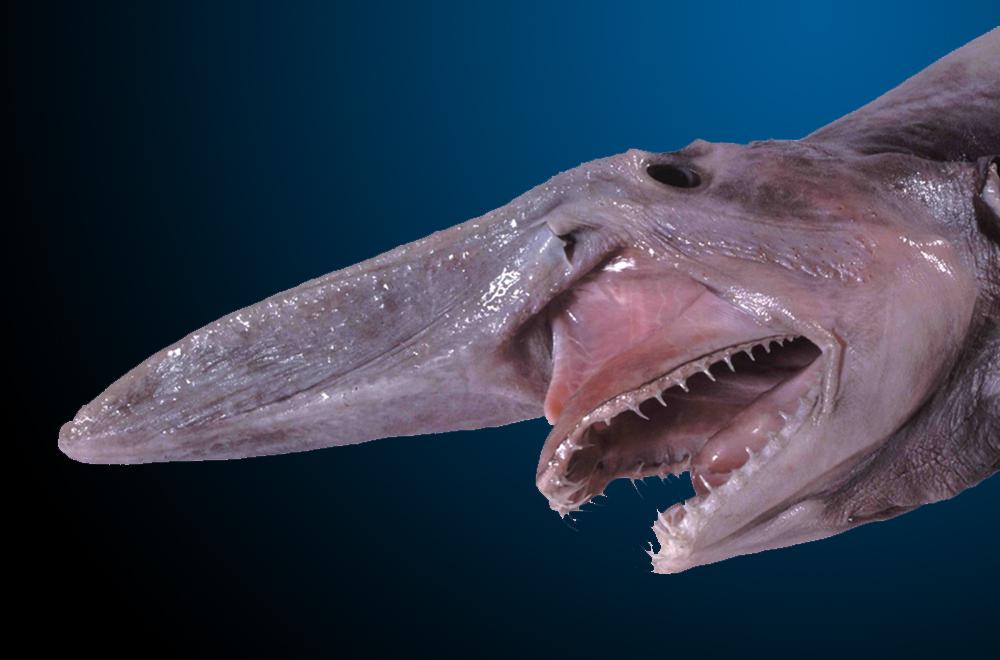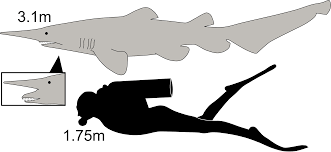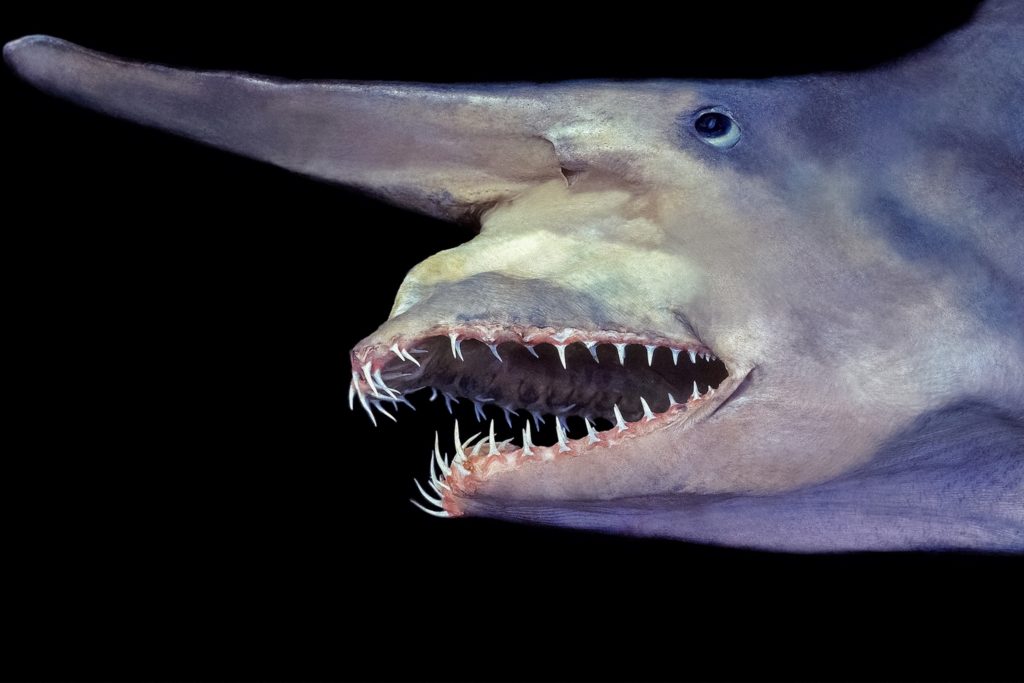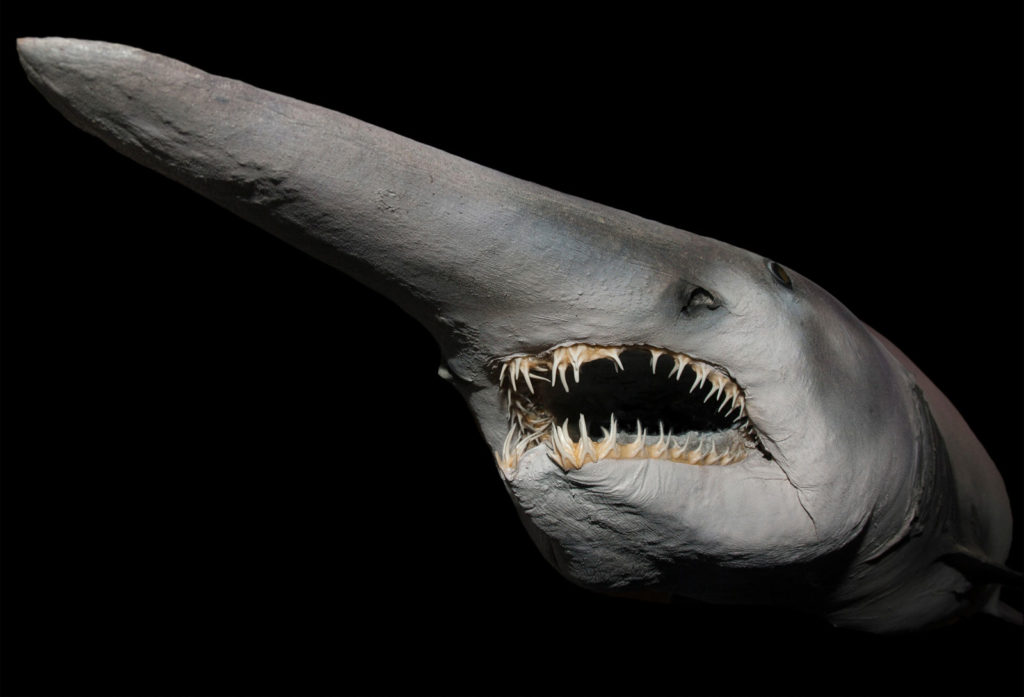Goblin Shark Facts

Have you ever wondered about what animals lurk deep in the ocean? If you answered yes, we’ve got you covered with one type of shark!
Goblin sharks are one of nature’s more unique creatures, with their long snouts and huge jaws.
In this article, we will take you through a list of facts about the goblin shark, including what it eats, how big it can get, and how its jaws work.
Let’s dive right in!
What Does a Goblin Shark Look Like?
Goblin sharks are one of the rarer shark species that you would find in the ocean. They are widely recognized for their long snout that is also called a rostrum, and their long teeth.
The rostrum or snout is long and flat, and it becomes smaller in size as the goblin shark ages. It is covered with several organs which help the shark detect prey in the water. As they live deep underwater, their environment is very dark, and therefore, their organs help them detect prey in a dark environment.
Their long snout looks similar to a blade.
Their long teeth are clearly visible even when their mouths are fully closed, indicating that all their teeth can’t fit into their mouths.
Goblin sharks also have slender bodies.
What Color Are They?
Goblin sharks are pinkish-grey in color.
The pink hues in their skin come from the blood vessels that are directly below the shark’s skin. As the goblin shark gets older, the color of its skin darkens. When goblin sharks are newborns, their skin is almost entirely white.
Their fins are usually either blue or gray, and they have black eyes. The goblin shark’s irises often have blue streaks in them. When a goblin shark dies, its color fades, and it becomes brown or gray.
How Big do Goblin Sharks Get?
Unlike the fictional characters that these sharks are named after, goblin sharks are enormous creatures. The average goblin shark measures anywhere from three to four meters long, or 9-13 feet long.

The largest goblin shark that was ever captured weighed 210kg, and it was 12.5ft long, or 3.8 meters.
Where Do Goblin Sharks Live?
Goblin sharks have been discovered in various parts of the world in the three major oceans, which shows us that this shark does not live in only one region.
For example, the goblin shark was discovered near Australia, Mozambique, Taiwan, Japan, and New Zealand in the Indo-Pacific and Oceania regions. In the Atlantic Ocean, the goblin shark was discovered near French Guiana, Suriname, and certain regions of Southern Brazil. Marine biologists also found it in the northern regions of the Gulf of Mexico.
This big fish lives in the deeper parts of the ocean, unlike other big fish that are often found closer to the surface and are easily spotted by researchers and marine biologists. They are found in submarine canyons and continental slopes.
What Do Goblin Sharks Eat?
Goblin sharks eat other fish, mainly teleost fish. These teleost fish include dragonfish and rattails, as well as anglerfish. Goblin sharks also eat various crustaceans like prawns, shrimp, crabs, crayfish, and cephalopods, such as squid and octopuses.
The most well-known prey of the goblin shark is the blackbelly rosefish, a bottom-dwelling fish commonly found in areas that goblin sharks live in. Researchers have discovered that the goblin shark tends to search for food close to the sea’s floor. Goblin sharks also look for food that is near the sea’s surface.
Goblin Sharks Teeth and Jaw
The goblin shark has a mouth that is shaped like a parabola. Its jaw is highly protrusible, which means that the shark can easily extend its jaw forward, almost the entire length of its long snout.

Goblin sharks have many teeth as well. They have around 34-53 teeth in their upper jaw and 31-62 teeth in their lower jaw.
They have long and narrow teeth in the central parts of their jaws, while their rear teeth are flatter and smaller to help the goblin sharks crush their prey quickly.
Open Wide
The structure of the goblin shark’s jaw is fascinating to look at and observe.
When the shark’s prey comes near it, the goblin shark’s jaws move forward thanks to two pairs of ligaments closely connected to the shark’s jawbone. The ligaments are pulled tight when the shark is resting, but when the goblin shark wants to feed, the ligaments relax, allowing the shark’s jaws to move forward.
During the process of the jaw moving forward, the shark’s tongue drops down. This means that the inside of the shark’s mouth expands, and the prey gets sucked in with seawater.
The goblin shark’s feeding style is unique because its lower jaw protrudes forward but swings upward simultaneously, which allows the shark to capture its prey. Many scientists believe that goblin sharks have such a complex jaw structure and feeding style because they are poor swimmers, and therefore, they can capture their prey quickly without needing to chase it.
Goblin Shark Behaviour
Goblin sharks aren’t the easiest fish to observe and conduct research on because they are seen very rarely. However, researchers have learned that goblin sharks live very lazy and inactive lives.
They are also solitary creatures that prefer to keep to themselves. Some researchers have discovered that they seem to be nocturnal, as they come alive at night and remain asleep or sluggish during the day.
Since these sharks live very inactive lives, they have weak muscles and soft fins. They also have skeletons with reduced calcium.
Bottom Dwellers
It is often found in the ocean at a depth of around 270-960 meters, or 890-3,150 feet. There have been times when the goblin shark was also caught more than 1,300 meters deep.
It’s important to remember that adult goblin sharks live deeper in the ocean than younger goblin sharks. Younger goblin sharks often live at depths of 100-350 meters, and they sometimes swim into areas less than 40 meters deep.
Slow Swimmers
It’s important to remember that goblin sharks are not fast swimmers, which means they capture their prey by ambushing them.
Researchers believe that goblin sharks are slow swimmers because they are deep-sea dwellers, and as a result, their food supply might scares. Therefore, they swim slowly to save energy for when they go hunting for food.
Goblin Shark Hunting Methods
Goblin sharks also have oily livers and low-density flesh, meaning that they are neutrally buoyant, which allows them to ambush their prey by slowly drifting or floating towards it. Since the goblin shark can drift quietly, it enables them to ambush their prey without getting caught. When their prey is nearby, the goblin shark simply uses its unique jaw structure to move forward and capture its prey.
Breeding and Reproduction
Unfortunately, scientists and researchers have not been able to observe pregnant female goblin sharks in the wild. Therefore, they do not know much about the breeding and reproduction of these fish.
However, scientists believe that goblin sharks share the same reproductive characteristics as other sharks. They think that goblin sharks are viviparous, meaning that an embryo grows inside the body of the female goblin shark. The embryos that grow inside the goblin shark during gestation are believed to participate in oophagy, consuming the underdeveloped eggs to help the embryo develop into a baby shark.
Researchers and scientists are unsure about when female goblin sharks mature sexually. However, they have discovered that male goblin sharks mature sexually when they are about 8.5 feet long.
Goblin Shark Family, Genus and Species
Goblin sharks belong to the family named Mitsukurinidae. Their genus is known as Mitsukurina, and their species is called M. owstoni.
Named After a Demon

Even though goblin sharks exist in various parts of the world, goblin sharks have often been seen around the Japanese coastline. Once, long ago, some Japanese fishermen accidentally caught this giant shark in their nets and realized that the goblin shark had a huge protruding snout. The shark’s snout reminded them of old tales that they heard as children about a demon with a red face and a long nose called a ‘tengu.’ As a result, they started to call these sharks tengu-zame, as ‘zame’ means shark in Japanese. When the Japanese name was translated into English, the translation was goblin shark!
Goblin Sharks in Hollywood
Goblin sharks have made a bit of a name for themselves in Hollywood! In Pacific Rim (2013), the kaiju character called Knifehead was modeled after the goblin shark. The film’s special effects team worked extremely hard to create the pointed snout that looks just like the goblin shark.
Threats to Goblin Sharks
According to the International Union for Conservation of Nature, the goblin shark has been categorized and listed as a creature of Least Concern, meaning that these sharks aren’t endangered or likely to be endangered in the near future.
Predators of Goblin Sharks
Since these sharks live very deep in the ocean, they are unlikely to have many predators. However, some researchers believe that blue sharks might attack and eat goblin sharks. Their other predators are humans because goblin sharks have been caught and displayed in museums.
Are Goblin Sharks Extinct?
No, they are not. It is hard to gauge how many goblin sharks there are on earth because they are rarely seen in the ocean.
Interesting Facts about Goblin Sharks
- Goblin sharks can open their mouths to an angle of 111 degrees.
- Goblin sharks are the only living members of their family, the Mitsukurinidae.
- These sharks can unhinge their jaws at a speed of 10 feet per second.
